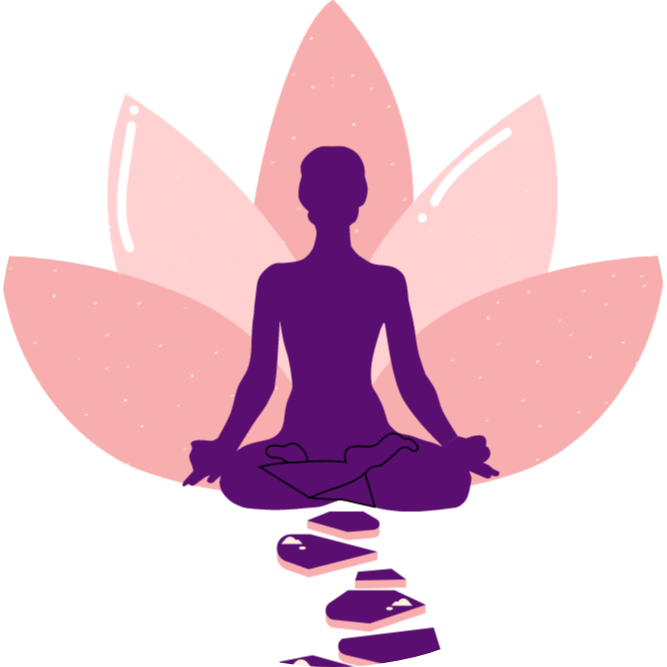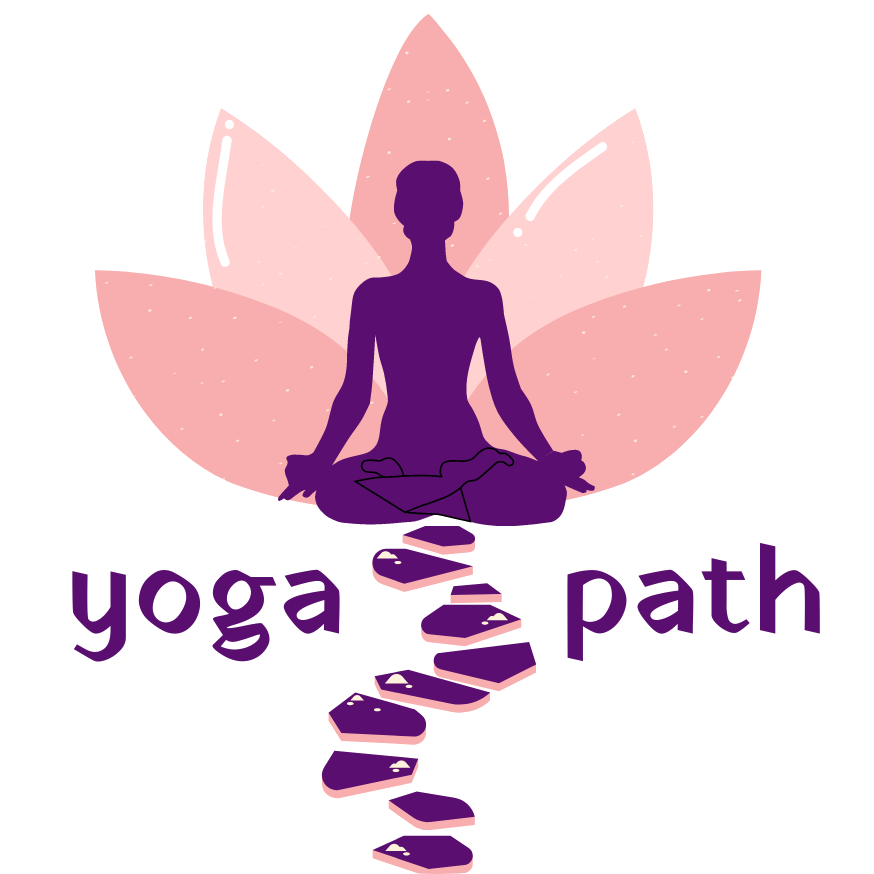Relief from Migraines
ASANAS TO REDUCE MIGRAINES
Yoga for relief from migraines
Migraine is considered a neurological disorder that causes recurring headaches with intense pain usually on one side of the head and is often accompanied by nausea and extreme sensitivity towards light or noise.
Stress is a common trigger for people suffering from migraines. Yoga asanas, breathing techniques and meditation can all help reduce stress and prevent the occurrence of migraines. Yoga also stimulates the parasympathetic nervous system which improves recovery from migraine attacks.
The Yoga poses detailed here improve blood flow to the brain, boost blood circulation, decrease tension in the neck and shoulders and stretch out the spine to reduce stress and relieve migraine pain and symptoms.
Incorporate these into your daily exercise routine to reduce the frequency of migraines and manage its symptoms, without any side effects.
Eye Palming / Cupping Eyes
Palming for the eyes involves cupping your eyes with your warm, energized hands. This simple technique relaxes our eyes, reduces the tightness around our eyes and allows you to focus your energy inwards promoting mindfulness which helps with easing the symptoms of migraines.
- Sit in a comfortable position, either on your mat or on a chair. Relax your shoulders and straighten your back.
- Gaze at a distance, take a deep breath in and exhaling, gently close your eyes.
- Rub your palms against each other for 10-15 seconds till they feel warm and energized.
- With your eyes closed, raise your palms and cup them over your eye sockets, with your fingers extending over your forehead. Be careful not to press into your eyes.
- Relax and be present with the darkness surrounding your eyes. Stay for as long as is comfortable.
- When ready, gently blink your eyes a couple of times within the darkness of your cupped palms.
- Slowly move your palms towards the side of your face and gently open your eyes.
Benefits:
Alleviates eye fatigue caused by strain
Defends against headaches
Relaxes the optic nerves and reduces muscle activity around the eyes
Increases the power of concentration
Supports the health of the photo receptors in our eyes
Reduces tension in the facial muscles
Prevents vision related problems
Reduces external stimulation, giving your parasympathetic nervous system to enable calm, sleep and deep relaxation
Restores the natural sparkle of our eyes
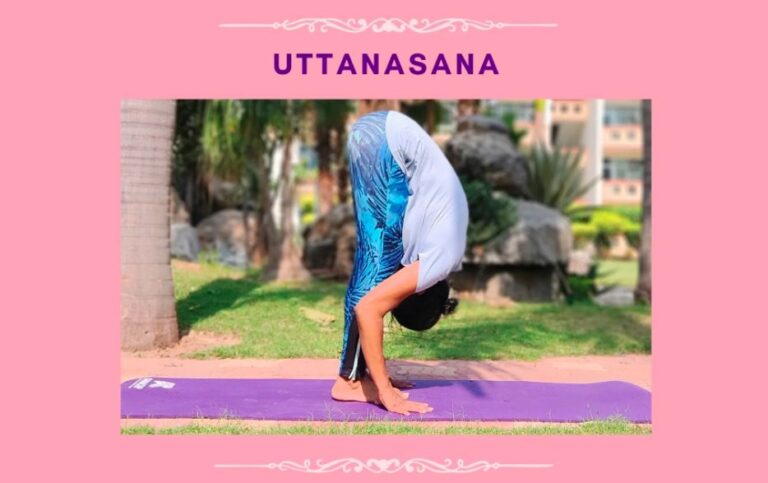
Standing Inverted Position – Forward Bend
This asana flows with humility and acceptance of the self along with surrender to the universe. It represents a cycle of energy generated within the body and offered to the universe.
- Stand with your feet together and hands at the side.
While inhaling, raise both your hands from the front above your head. - While exhaling, bring the your hands down to touch your toes or grasp your ankles keeping your knees straight.
- Remember to keep your ears and hands together as a unit as you bend down or rise up.
- Keeping your knees straight, try to touch your forehead to the knees. Stay in the position for 6 seconds breathing normally – extend to 2 minutes.
- While inhaling, raise your hands up above your head and exhaling bring your arms down to the sides.
Contraindications:
Hypertension, Cardiac ailments, Pregnancy, Peptic ulcers, Hernia, Back or Spinal Injuries, Cervical spondylitis, Slipped disc and serious Eye disorders such as glaucoma and myopia.
Benefits:
Results in extreme stretching of back and leg muscles
Brings flexibility to your spine
Increases the blood circulation to refresh your nervous system. It also calms your mind and prevents migraines.
Abdominal compression provides good circulation and massage to abdomen and pelvic organs
Tones the abdominal wall and reduces unnecessary fat deposits in the abdominal area
Induces clavicular breathing and aids proper ventilation of the uppermost part of the lungs
Stimulates the nervous system and endocrine system
Improves blood circulation
Aids sleep

Uttanasana Variation – Rag Doll Pose – Forward Bend
Hastapadasana meaning Hand to Feet Pose
By allowing your head to bow towards the earth and letting go of all tension from your neck and spine, the gentle hug from gravity can help with your headache pain, and create space in the spine and neck.
- Stand with your feet together and hands at the side.
While inhaling, raise both your hands from the front above your head. - While exhaling, bend from your waist, bring the your hands down to touch your toes.
- Now hold your opposite elbows with hands, bend your knees slightly and just let gravity pull your upper body downwards.
- Stay in the position for 6 seconds breathing normally.
- While inhaling, raise your hands up above your head, rise up and exhaling bring your arms down to the sides.
Contraindications:
Hypertension, Cardiac ailments, Pregnancy, Peptic ulcers, Hernia, Back or Spinal Injuries, Cervical spondylitis, Slipped disc and serious Eye disorders such as glaucoma and myopia.
Benefits:
Helps relax your spine
Allows blood to rush to the head, boosting circulation
Releases tension and helps prevent migraines
Increases the blood circulation to refresh the nervous system.
Stimulates the nervous system and endocrine system
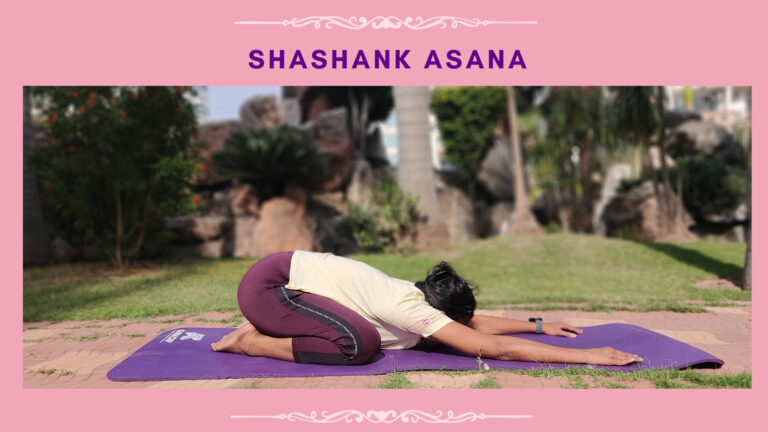
Shashank Asana – Prone Position Forward Bend
Shashank Asana meaning Hare Pose
Shashank Asana is a great way to release tension from your upper body and open up your shoulders, back, and spine, which can increase blood flow to your head. When the forehead is rested on the ground, many pressure points are activated, which can relieve migraines and headaches.
- In this asana, sit in Vajrasana resting the palms on the thighs. Spread the knees out.
- Inhale and raise the arms above the head. Elbows must be straight, maintain shoulder width apart distance between the arms.
- Exhale and slowly bend the torso forward and place forehead palms, elbows and arms stretched out in front between the knees on the floor.
- Bend from the pelvic region. The hips should remain touching the heels. Retain the position as long as comfortable. It could be practiced from a minute to 5 minutes.
- To go back in the base position, exhale and slowly lift the forehead, arms above head. Lower the arms resting the palms on the thighs. Relax and take deep breaths.
Contraindications:
Vertigo, high blood pressure, knee problems or slipped disc.
Pregnant women should refrain from practising this asana.
Benefits:
Massages the abdominal organs, muscles and organs of the pelvic region.
Improves digestion and alleviates constipation.
Relaxes the spine and all muscles of back.
Improves functioning of adrenal glands.
Stretches back muscles and strengthens it.
Enhances the health of reproductive organs.
Relaxes sciatica nerve.
Improves blood supply to the head and therefore nourishes the eyes and all brain functions.
Helps to relieve fatigue and promotes concentration.
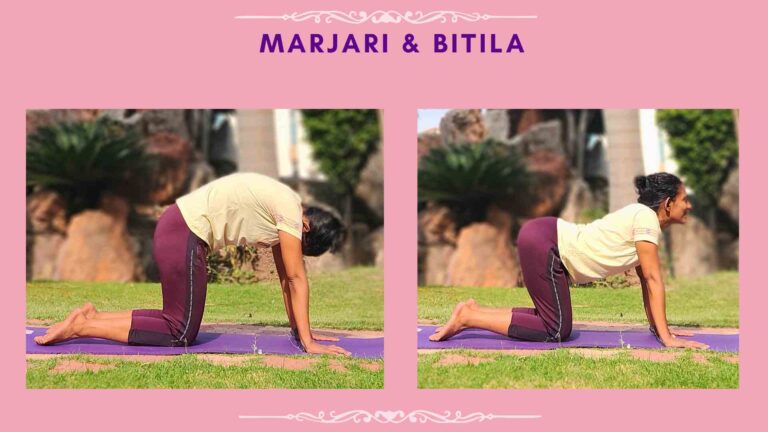
Marjari & Bitila Asana – Forward & Backward Bend
Marjari meaning Cat, Bitila meaning Cow
Moving between Marjari and Bitila asanas not only relieves tension in your upper body, but also boosts your blood flow and circulation. This oxygenates the brain, which can help ease pain from migraines.
- In this asana, sit in Vajrasana then come on all fours or table top with with knees and palms on the floor. The palms are at shoulder distance on the floor also the knees and feet are at hip distance apart. The palms are directly under the shoulder with arm perpendicular to the floor and the knees are under the hips. Look straight ahead.
- As you inhale, raise your chin, tilt your head and chest back pushing the palms firmly into ground push your navel downwards and raise your tailbone. Hold this cat pose and take long, deep breaths.
- Follow this by Bitilasana, a counter pose: As you exhale, drop your chin to your chest and arch your back up as much as you can; pull in the pelvic and chest to form a curve in the spine. Hold this pose for a few seconds.
Contraindications:
Weak wrists injury or surgery to wrists
Shoulder injury back injury
Weak or injured knee – use padding under knees
Benefits:
Brings flexibility to the spine
Stretches the back and relaxes it
Stretches the scapula out and in and increases mobility
Strengthens lower back
Strengthens wrists and shoulders
Massages the digestive organs and improves digestion
Tones the abdomen
Relaxes the mind
Relieves menstrual pain
Improves focus
Improves blood circulation
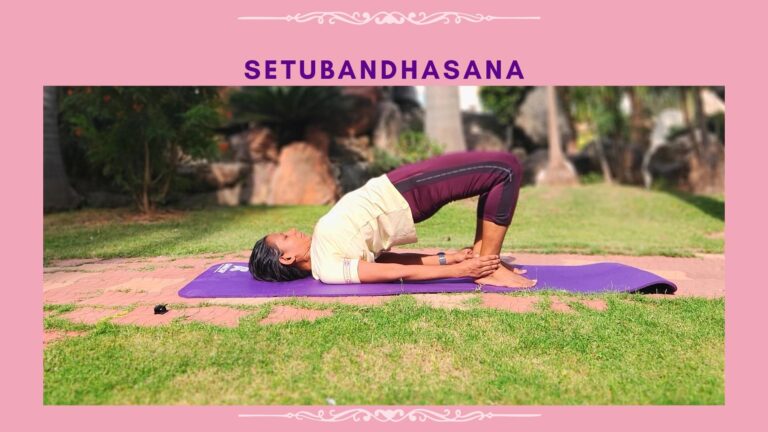
Sethubandhasana – Supine Asana
Setu meaning Bridge; Bandha meaning Bind or Lock.
A major trigger for migraines can be holding tension in the shoulders and neck. Sethubandasana relaxes your upper body and can increase blood to your brain as your heart is lifted above your head.
- To begin, lie on your back. Fold your knees and keep your feet hip distance apart on the floor, close to your pelvis, with knees and ankles in a straight line.
- Place your palms on your ankles. Inhaling, slowly lift your lower back, middle back and upper back off the floor; gently roll the shoulders inwards; raise the chest to the chin supporting your weight with your shoulders, arms and feet.
- Both the thighs are parallel to each other and to the floor. Hold this pose for few breaths. exhale as you gently release the pose.
Contraindications:
Neck injuries, Shoulder or back injuries or surgery, Hypertension, Heart ailments, Myopia and Glaucoma or retinal detachment.
Benefits:
Strengthens the back muscles
Relaxes back instantaneously
Gives a good stretch to the chest, neck and spine
Opens up the lungs and reduces thyroid problems
Strengthens glutes and quadriceps
Calms the brain, reducing anxiety, stress and depression
Helps improve digestion
Helps relieve the symptoms of menopause and menstrual pain
Helpful in asthma, high blood pressure, osteoporosis, and sinusitis
Adho Mukha Svanasana – Inversion Asana
Adho meaning down, mukho meaning Face, svana meaning Dog. This asana too is part of the flow of surya namasakar (salute to the sun).
The name is derived from the way the dog stretches his front limbs when getting up.
In this pose, we can start by sitting on all fours in a table top position with knees and palms on the floor. The palms are at shoulder distance on the floor also the knees and feet are at hip distance apart. Lift the knees up to raise the hips up as you inhale. The weight of the body is on both palms and feet. With both arms straight at the elbows and the legs being straight at the knees the hips are raised up the head is down with arms close to the ears. We try to press the chest into the thighs just as we try to close a book to make a V shape. As you exhale, lower down the knees, hips and back into table top.
Contraindications:
Pregnant women, high blood pressure, Weak eye capillaries,
detached retina, or any other infection or inflammation of the eyes and ears and shoulder or back injury
Benefits:
Stretches the hamstring and calf muscles
Strengthens arms and shoulders, legs and ankles
Relaxes and strengthens back muscle
Strengthens abdominal muscles and core
Improves posture
And calms the heart
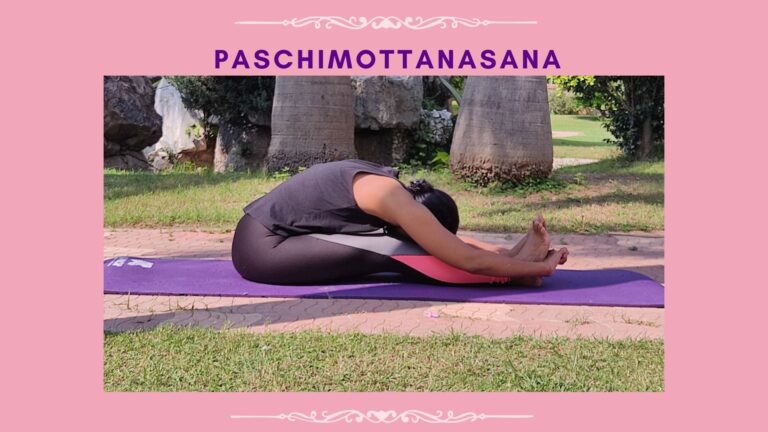
Paschimottanasana – Seated Asana
The word ‘paschim’ meaning ‘west’ meaning posterior part of the body and ‘uttana’ for stretching i.e. this asana is a posterior stretch.
This pose stretches out your spine and opens up your shoulders, both of which relieve some of the tension often associated with headaches and migraines.
- For this asana, sit on a mat with legs fully stretched out and toes facing upwards.
- Keep the spine erect, shoulders rolled back sitting on the sit bones. Hands besides the body, palms facing down.
- Raise both the arms up and lower down and bend forward and stretch the hands to touch the toes while drawing in the abdomen.
- Gently pull the elbows down to touch the ground and bend the head to bring the forehead to the knees.
- Hold here for a few seconds breathing normally.
- Return to starting position: Raise the head and hands up, gently straighten the back and bring the hands to the sides.
Recommended practice: Practice once – maintain the final position for 30 seconds, gradually taking it up to 1/2 minutes with regular practice. Breathing should be normal–slow and rhythmic.
Contraindications:
Hernia, hypertension, heart ailments, pregnancy, peptic ulcers and abdominal inflammations. Hyperthyroid, serious spinal disorders, myopia, glaucoma and serious eye disorders.Benefits:
Helps in correcting minor deformities of the curvature of the spine and improves blood circulation.
Deep intra-abdominal compression massages the abdominal organs provides relief to constipation, weak digestion, sluggish liver.
Stretches the muscles of the legs the hamstrings, shoulders and the back.
Helps in cases of sciatica and lumbago.
Strengthens the sense of surrender, dedication and commitment.
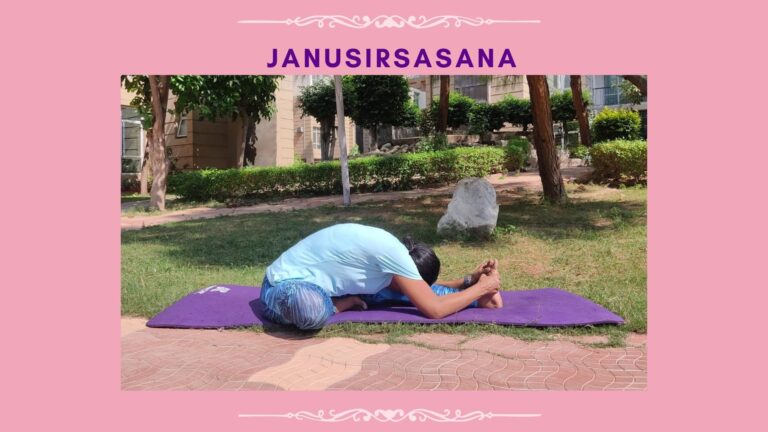
Janusirsasana – Seated Asana
In Sanskrit, Janu means Knee or Knee Joints, Shira means Head and Asana mean Pose, hence this pose is also known as Head to Knee pose.
This asana increases blood circulation and improves blood flow to the brain, which in turn helps to reduce stress, anxiety, headache, and migraines.
- Start by sitting down on the floor with your legs stretched in front of you and your arms at your side. Keep your back straight.
- Bend your left knee and place the left heel near the groin.
- Inhaling, raise your arms over your head and stretch your upper body.
- Exhaling, bend your upper body forward, touching your forehead to your right leg. Try to hold your toes or wrap your hands around the sole of your right foot.
- Hold this position for couple of seconds and slowly return to the original position.
- Now repeat the same with the left leg.
Contraindications:
Severe back injury, hip injury, ankle injury and knee injury. Any surgery on the back or waist. Spinal column ailments on the lower vertebrae. High or low blood pressure and Hernia.
Benefits:
Strengthens the neck, shoulders, back, abdomen, legs and hips
Reduces back pain and improves blood circulation
Improves digestive health and helps to reduce belly fat
Improves the function of liver and kidneys
Improves cardiovascular health
Helps to reduce menstrual and menopausal disorders
Overcomes pain from Sciatica
Relieves stress, decreases anxiety and reduces the pain of migraines
Shavasana
Supine Position – Relaxation Pose
Shava meaning Corpse.
This pose gets its name from the reclined posture of a dead body. It is a position of rest, relaxation, and rejuvenation is usually practiced towards the end of a yoga session.
- Lie flat on your back and close your eyes. Keep your legs at a comfortable distance apart and relaxed and toes facing to the sides. Place your arms a little spread apart from your body. Leave your palms open, facing upward.
- Taking your attention to different body parts one by one, slowly relax your entire body.
- Begin with bringing your awareness to the right foot, move on to the right knee (in the same way you complete one leg, and move your focus to the other leg), and so on, and slowly move upwards to your head, relaxing each part of the body.
- Keep breathing slowly, gently, deeply and allow your breath to relax you deeper. The incoming breath heals the body while the outgoing breath relaxes. Make sure you don’t fall asleep!
After some time, about 5-20minutes when you feel fully relaxed, keeping your eyes closed, slowly roll onto your right side. Lie in that position for a few seconds or so. Then, with your eyes still closed, sit up into cross legged pose (Sukhasana) taking the support of your right hand. Take a few deep breaths in and out.
When you feel completely in touch with your surroundings, slowly and gently open your eyes.
Benefits:
Deep, meditative state of rest, which helps in the repair of tissues and cells
Releases stress
Helps rejuvenation
Reduces blood pressure, anxiety, and insomnia.
This is an excellent way to ground the body and reduce the Vata dosha (imbalance of the air element) in the body.

Sushma Vyayam – Warm up Exercises
Sushma Vyayam or warm up exercises conducted at the start of a yoga session help to loosen tight areas of the neck and shoulders which hold stress, and this can prevent the recurrence of migraines.
